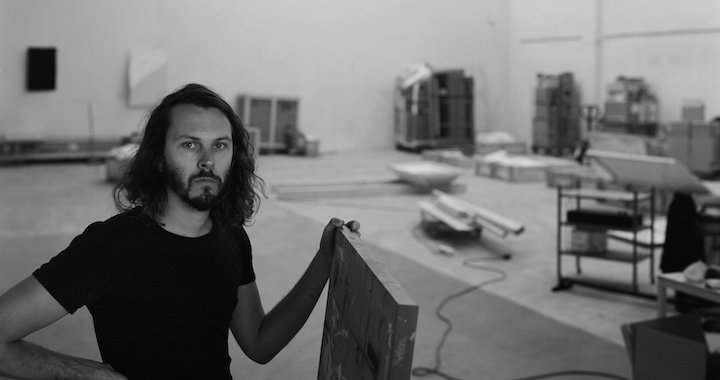
Dream big, see it fail, repeat
An interview with James Beckett
31/08/2018
The presence of the 1st Riga Biennial can also be felt by citizens who don't care to visit the indoor exhibitions, mainly due to the several artworks that are situated in the public space near the exhibition locations. Perhaps the most notable of these is something that appears to be a large, blackened model of a strange building that constantly emits smoke and ominous ambient music. Placed in a busy pedestrian road intersection in a park near the former Faculty of Biology, this ‘model’ is the piece called Palace Ruin by James Beckett. One would be amiss not to point out that it actually isn't smoking constantly, for the amount of smoke emitted depends on the intensity of the pedestrian traffic around the object. And the building it depicts might seem strange only because its real-life counterparts are virtually extinct from the world now: the utopian ‘crystal palaces’ that were built throughout industrialised Western Europe during the 19th century to celebrate the progress of industry and international trade, and the benefits these advances bring to the nations. Palace Ruin in particular is the reconstruction of the framework of the Paleis voor Volksvlijt (‘Palace of Popular Diligence’) in Amsterdam, which was constructed between 1859 and 1864 and burned down in 1929. The spooky black steel construction in Kronvalda Park resembles something between a mausoleum, a temple, and a Gothic house of horrors.
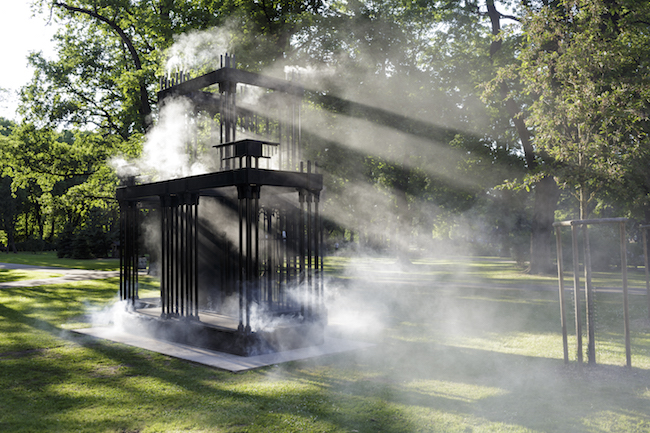
James Beckett. Palace Ruin. Photo: Andrejs Strokins
The author of the work, James Beckett (1977), is an artist and professor who currently resides, works and teaches in Amsterdam. Born in Zimbabwe, he spent his childhood and adolescence in South Africa; he moved to Europe in 2000 and has stayed there ever since. Beckett’s artistic interests lie in the intersection between art, science, history and social critique. Often drawing inspiration from small, accidental, often absurd historical or factual discoveries, Beckett then builds his research around a particular historical person, event or phenomena and lets the results of his research appear in non-didactic, unpredictable artistic manifestations within a wide spectrum of genres and techniques. He is particularly interested in the industrial modernity of the late 19th and early 20th centuries, believing that the class differences of early neoliberal society are alive and well today, and that placing objects that concern another historical period into a contemporary context can illuminate these similarities. This is exemplified by Palace Ruin, for which Riga isn't the first place of exhibition.
Beckett graduated from the Royal Academy of Arts in Amsterdam in 2002, and since then has been admitted to various prestigious residencies, such as Wysing Arts Centre in Cambridge, Centre International Des Récollets in Paris, and FLACC in Genk. Works he has made over his career are now a property of various galleries and museums, including Stadelijk in Amsterdam and Centre Pompidou in Paris. In 2003, Beckett was awarded the Prix de Rome Art & Public Space prize.

James Beckett. Palace Ruin. Photo: Andrejs Strokins
So why, of all your works, was Palace Ruin the one to appear at the Riga Biennial?
In Amsterdam, where this piece was originally made, it was quite site-specific. It was originally shown in a corporate environment, as a reflection on the heritage of a certain kind of architecture. It was a provocation in that environment – as a ruin, as a disaster. Why I have now brought it to Riga is perhaps more connected to the history of the crystal palaces as exhibition halls. These ‘palaces’ were originally designed for trade and inevitably to connect people. One by one they basically burned down, so in retrospect, they in fact became the opposite of what they were intended – quite perilous places, at least symbolically so. The world is shifting in a significant way right now, and being here, as a sculptor, with Latvia’s proximity to Russia... this could be described as a moment of reckoning.
And what is this ‘reckoning’?
Well, such ‘palaces’ were a utopian project in which they amplified the (then) modern technological ways of building – an amplification which became an ideological framework. Within this utopiansim was an element of altruism, intentions born of the idea of mankind enhanced through industrialisation. Inevitably, they mostly had short lives as architectural structures and were humbled with short life spans – a kind of enforcement of nature. So, in terms of reckoning, in this instance, it was about thinking large and having it fail. It was as much for technological advancements, industrial advancements and trade as it was for humanity, you know, for trust. For example, these structures also hosted cultural programs that were intended to have an educational component for the middle classes... a so-called ‘civilising offensive’. This was a patronising yet well-meant gesture – very telling of the times.
Don't you think the cycle of thinking large and having it fail is one observable throughout human history, and not only in modern times?
It's definitely a necessity to be able to dream, you know? Then, later, comes the filling in of the practicalities and the implications. Otherwise you're not aspiring to anything. This type of architecture really embodies a kind of risk-taking.
Why did your focus shift to this monumentalist architecture of the 19th century, to capitalist ideology, to the control of the masses? Why exactly to that phenomena of history, as opposed to any other?
I guess it's a reflex of mine; I've always been very interested in this period, the Victorian era. It was a period when everything in terms of technology was still very explicit and self-explanatory. We now have very complex and intricate technologies, inexplicable and existing on scales no longer even visible. I was also particularly moved by the biography behind this building: it was initiated by a man named Samuel Sarphati, and for him it was not just a patronising or ‘civilising offensive’ to educate the working class; he was truly trying to improve the lives of people in the city. He was a physician, a doctor; he brought clean water from the dunes on the coast to the centre of the city at a time when water in the city was very polluted. He broke the syndicate of bakers in the city who had fixed the bread prices, which meant people had been paying a lot more than was necessary. On top of that, this gift of architecture to the city was meant not only for industrial trade and exhibitions, but also for showcasing regional culture. So in that sense, it's an interesting biography... but to return to your initial question about this piece and Riga... I think the Baltic context is an interesting one. Katerina Gregos has always been a very politically engaged curator. She's involved in effecting change – basically, programming quite essential conversations for our times. In her curatorial title of Everything was forever, until it was no more, there's an acknowledgement in which we see things which are often proposed as dominant and permanent, shifting register – much like the communist presence that was once here.
Or as the national state is perceived now.
Exactly. And it is the same for capitalism. This piece comes very much from a neoliberal critique, but in this context, it's an open reflection in all directions. Because construction of such palaces signified the birth of neoliberalism in the sense of communication and connecting for trade, but in the same sense, the ideological principles resonate very much with the principles of a communist connectivity... In retrospect, I think, it's easy to criticise such initiatives, but in reality, they had a big effect in a short period of time: they gave people a sense of purpose; it was about building something with a quality of transparency. It all required quite the entrepreneurship from characters like Samuel Sarphati. And, yes... It is also a bit of a tragedy... You know, looking at the politics of the moment, including those of the Baltic States in relation to Russia...
How exactly does that relate?
To this?
Yes.
Well, there has been critique directed at the biennial because of its funding coming from, to a large extent, from Russian sources. I think this makes quite tangible the volatility of relationships in this region. I will also be working in Ukraine later this year, with a collection directly relating to the 2014 revolution – objects from the Euromaidan protests. Geo-politics are a tangible reality in a lot of people's day-to-day experiences in post-Soviet states.
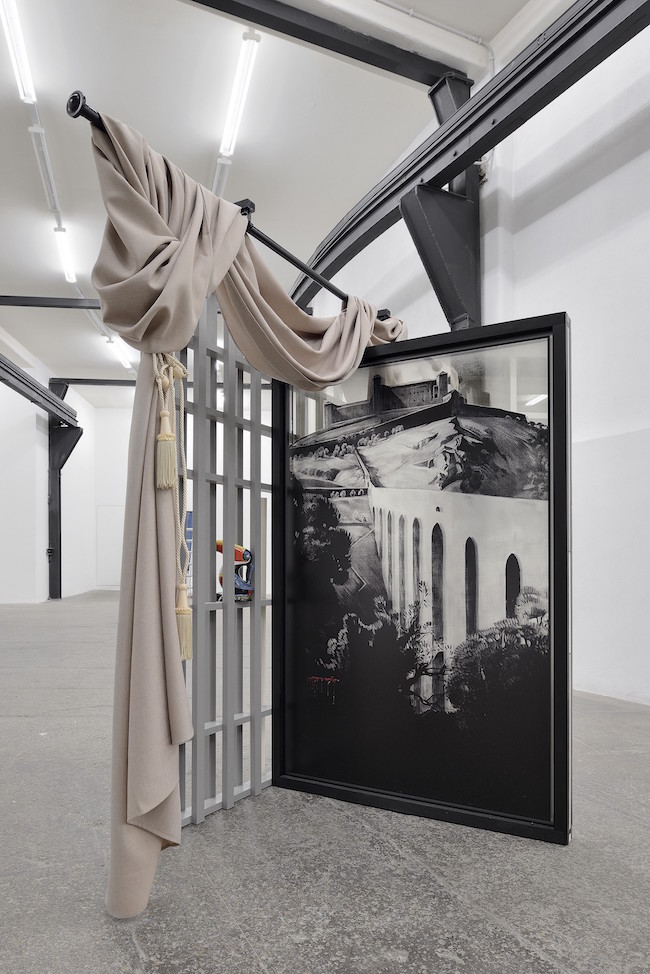
James Beckett. Lady Henrietta Guinness 2, 2017 (The Guinness Curse). Wood, UV printed mirrored glass, custom-made Guinness velvet, steel rod, drapery, tassels, porcelain tucan. Courtesy T293, Rome, IT
Why do you bring it up at all? How does it come together with the critique of neoliberalism?
I think it's been a conversation within the biennial from the start. Because of how volatile the situation is. And, I think, if I was working in many other countries, it would be similar. Cultural influencing from dominant neighbours is a thing. The US has always been mingling in other countries’ affairs. I think to connect it to neoliberalism is not altogether unrealistic. To free trade... What is neoliberalism composed of, really?
Would you say that, in a way, you're also critical of the biennial itself?
No, I would not say so. Palace Ruin is an already existing work – if that’s what you mean.
But it works like that in this context?
It can function as a kind of mirror. It's quite a caricature; it has an odd status because it looks like it's from a theme park or something but, I think, because of its history, it starts to resonate with some of these conversations. I wouldn't say I'm very educated in these circumstances, but I feel it. My interest is much more in the architecture, to be honest. It started from quite a formal inclination and very quickly became...
But were you aware of this critique already before the biennial?
Yes. And I had questions as well, you know, because... It's almost like a hangover from history that we're experiencing at the moment. I'm South-African, you know.
I thought you were born in Zimbabwe.
Yes, I was born in Zimbabwe but grew up in South Africa. And identity politics were a large part of my upbringing – to the point of becoming sickening. I found it to be a kind of claustrophobic culture, whereby one was continually having to process and justify being white in that context. Being so far south in South Africa, I was entertained by the idea of Europe as a kind of enclave of rationality... But nowadays the debate here is increasingly becoming so flattened, you know, with the rise of populism... So, I think this past moment in history, the moment of crystal palaces, you could say, is connected to what's happening now – idealism vs reality.
Why and when did you move to Europe?
In 2000; when I was 23, I moved to Germany to do post-graduate studies. This was difficult to do in South Africa at the time. There was little infrastructure after education, so when we did something, we usually had to set everything up ourselves. It felt like we were doing important work, but it was very difficult to get stuff done.
And what was this work you were doing?
Just setting up exhibitions, renting warehouses... making contracts with shipyards, warehouses, stuff like this. It was almost like from a rave-party mentality, you know. Getting into old buildings and then doing something...

James Beckett. Lucy E. Guinness 3, 2017 (Detail The Guinness Curse). Wood, UV printed glass, Guinness coasters, tube light, custom-made Guinness velvet, Guinness salt and pepper shakers, tassel, page from “Across India at the Dawn of the 20th Century” (Lucy E. Guinness, 1898). Courtesy T293, Rome, IT
Have you studied architecture as well?
No, I haven't. But I'm an enthusiast.
And how does that unfold – your enthusiasm? Besides this work.
I guess that in this case, it was like with a lot of the rest of my projects... I usually follow biographies and company histories. You just follow these sorts of obscurities, you know, through various countries and periods and they become very telling – you can connect them. So it's quite a rambling thing, like, it almost grows like a plant... What this particular research of mine has gone into is the modern skyscraper fires, like...
Like Grenfell Tower in London...
Yes, for example. So that's a phenomena caused by, in part, cheap cladding. It's because of their external facades that these buildings are burning. In particular in Dubai, before the Grenfell Tower incident, there was a series of fires in skyscrapers and also on some yachts, all of which were built of similar composites... It's this insulation foam, which is very functional in the sense of keeping a building warm or cool, but it can also be dangerously flammable. At the same time, it's very cheap to produce, so it's being used a lot. It also creates a fatal sheath for a building. In a short space of time, a building will be damaged on the outside to the point that it has to be demolished. It's quite tragic and wasteful, not only of human life but in an environmental sense, too. In Dubai, it really goes hand in hand with quite an extreme mode of the capitalist means of production. They basically have a form of slave labour there: mostly people of south Asian descent who have their passports confiscated and then work at very low wages in really bad conditions to build these luxury apartments. To call it slave labour is contentious, but it amounts to that.
And is there also a contemporary parallel on the ideological take on the masses or on the people?
I think there are distinct differences. For example, back then, governments of countries and cities were funding utopian projects like crystal palaces. Now such equivalent mega-structures are corporate ventures – the kinds of buildings that are burning now seem to be overwhelmingly residential.
It’s a bit of a tangent, but in the early 1900s there was an architecture exhibition/fair here in Riga, right in this park where we’re sitting now. The park had many small pavilions or projects – follies of sorts. It's this language of a shrunken piece of architecture, when you entertain something of a certain scale, but you can't have the actual thing, so you have this representative... But it's not a proposal to build it – it's usually a destination unto itself, so we can call it a folly.
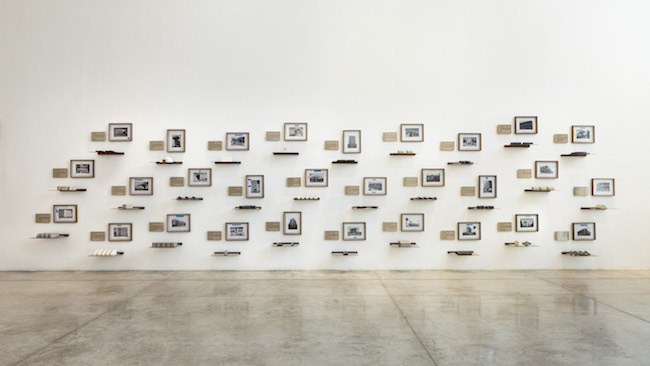
James Beckett. "Negative Space: A Scenario Generator for Clandestine Building in Africa" (2015). MCAD, Manilla, analogue version. Courtesy the artist
When you consider a separate work of yours, how long does it usually take to do the research, to follow the biography of a particular person or company, and then to come up with a work that represents everything you have put into it?
It varies from around three months to a year, and some things just sit on the shelf and never really become anything at all. I think it's not to be misunderstood as a historical or journalistic kind of work... Because I don't have the intentions of, like, basic storytelling. I'm dealing a lot more with absurdity rather than rational historical events. For instance, for me it's often finding something in a magazine... I read a lot of New Scientist magazine about ten years ago (I had a subscription), and now it's usually The Economist... And what often happens is, you find a small clip of something, a small passage or footnote, that becomes a simple blueprint for some kind of connection.
So it's always by chance or accident that you stumble upon something.
Yes. It's a kind of flavour that will begin a journey, and then afterwards you can start to connect and build on some kind of scaffolding for that, you know?
Do you remember the exact inception of Palace Ruin?
No, I don't. But for some other projects I do, quite vividly.
How long did it take to build Palace Ruin?
I don't know, about four months?
Did you do it all by yourself? I mean, work with steel – welding it, fusing it, etc?
No, there was a team of people, probably about twelve people. There was a company involved that also does the welding... So it's quite a production. To be honest, fundraising is more work than making the actual thing.
And when you move it, you move it in parts?
Oh yes, it's all in parts. In theory, you can move the whole thing just with human hands. You don't need a crane. But it gets a bit dangerous.
Is it that light?
Each of the elements are about 200 kilos, so it takes 4 people... But that's true to the original intention – the Crystal Palace was also possible to reassemble. And that's the contrary thing about stadiums, you know? At the moment, we're building stadiums a lot... We have this phenomenon of terribly explicit display architecture that has but one function. It's not adaptable, and it's not reconfigurable, you know – you can't disassemble it, you can't transport it.
For every World Cup you get 12 new stadiums.
It's disgusting. So, in, 1851, almost 170 years ago, you had the modularity and transportability of the Crystal Palace – an answer for stadiums in the most primitive form. And they haven't exploited it. It's ridiculous. The same goes for IKEA furniture – it’s designed to be taken apart again, but with patience and care. People try to take it apart, and it breaks. So we kind of have a very ‘one size fits all’ broken model. I think there exists a certain romanticism about technology, as well as about the ideals of building in these ways. The Crystal Palace was built at one location in London, and then it was dissembled and reassembled up on the hill which is now called Crystal Palace, and which is where it burned down. So it's very possible, you know (to apply these principals). And it's a shame it's not being done.
Where do most of your works now reside?
Oh, the objects? In some museum collections, in some galleries, in some private collections, some of it has been destroyed... Not too much, I keep most of the stuff... This was in storage for a year until it was brought here again...
Where does it reside in storage?
In a camping space outside Amsterdam. You want things to by kept shiny and intact, but there is an environmental concern – you don't want to spend money on maintaining these materials because they're poisoning the environment. There's always a compromise in these pieces. I've been trying to address that, but this is an environmentally friendly project by little means. So that's a challenge. And, increasingly, every time you make new work, you are faced with these environmental questions. It's very difficult to solve them.
Why do they concern you?
Because we're fucked. (Both laugh.)
Alright, that's a fair answer.
Don't you feel about it that way? About the environment?
.jpg)
I think that in Latvia, people who don't think about it are in the majority. A lot of people who I know, including friends – bright and educated people – don't realise that or refuse to think about it. The information is out there, but it doesn't reach the minds of the people. My surprise about that is actually bigger than my worries. Perhaps that's why I'm asking that.
What do you do personally to reduce your footprint?
(Thinks.) That's a tough one. (Laughs.) I mean, I'm a vegetarian. But I still eat fish. But not meat. But for vegetarians, there is usually a lot of soy consumption, of course, which is also responsible for a lot of deforestation... I recycle all paper and plastic in the studio and household, and travel as little as possible – only when it's essential. I've cut down a lot on travel. I did quite a complex project in Manila recently, but I was able to do it all online. A lot of these things are not necessary. Flying – that's a huge impact on your footprint. And I'm from a diaspora, so my family is in Switzerland, England and South Africa, and every time we get sentimental, like – oh, mom, why don't you come?! – fuck that, be responsible! Plan it out, do the whole family gathering together, two times a year, don't go too far, don't get too exotic, think about where we can, you know, use the train, which is like a quarter of a flight emission...
How do you move around in the Netherlands?
Just by bicycle. I don't have a car.
And if you have to go from Amsterdam to Rotterdam?
It's all by train. But the Netherlands have a terrible footprint as well. We have a mere 2% of green energy.
What are you, by the way? In terms of citizenship.
I'm a British citizen, as my mother was born in Scotland. But I have blood from all across Northern Europe.
And your father is...?
He's like 6th generation South African, but there it is a mixture of everything. We even have blood from Kaliningrad, of all places – I believe it was a part of Prussia then.
How was your family influenced by Mandela's revolution?
It was an interesting time. Quite tragic as well. The transition was much easier for most white people than for black people, of course. We have the biggest wealth disparity in the world. The difference between the poor and the wealthy is huge. And you feel that. So it's often quite depressing to go back there for this reason. Thinking back to the period, it was difficult to relate to folks across the whole spectrum. The majority of white families employed black families, you know. For housekeeping, for their businesses. And often it's a large part of a family that's employed with your family. So the cousin of the lady who's working in the house would be working in the garden, stuff like that. Within these strange hierarchies, we developed friendships, often motherly relations, yet with such an impossible physical and psychological distance at the same time.
So you had black friends as a kid.
Yeah, but not with ease. Aside from the cultural differences, there was the way apartheid was set up in terms of city planning and logistics – most black people were living outside of industrial regions, in townships. So you'd have the city centre, then you'd have the residential areas, the industrial areas, and then you'd have the townships. So it was the plan of the government to disenfranchise people of colour, to keep people separated. Poor people were basically spending a lot of their income on transport, to move around. This made it difficult to build and maintain friendships. Even after public schools became integrated, and this distance was closed, it still took time.
My last question, perhaps. Do you identify yourself as an artist?
More recently I've been identifying as a teacher, which has been an interesting thing. Normally people are romantic about being an artist, no? They like to be associated with it, but then being a teacher involves a different kind of responsibility – an inter-generational responsibility (Laughs.) Which is a funny thing to play with. Yeah, but being an artist is becoming less and less romantic, actually – it’s becoming more and more about production. It's a difficult job.
Because that’s what the art world, the industry demands?
Well, the remote view could be that the practice is like that of an Indian mathematician who needs only a pencil and paper. But in reality, you maintain a studio, you are your own bookkeeper, your own fundraiser, etc. It's pretty tough. And within that, you try to nurture some healthy poetics, which should actually be the core. But the reality (at least for myself) is that you're constantly de-romanticising these poetics through your means of participation. And it has only been amplified through social media and things like this. You could say there has been a lot of disenchantment around the practice, so, in a way, to be disconnected is quite a healthy way of being an artist. That brings us back to the importance of dreaming, not necessarily dreaming big, but just dreaming...
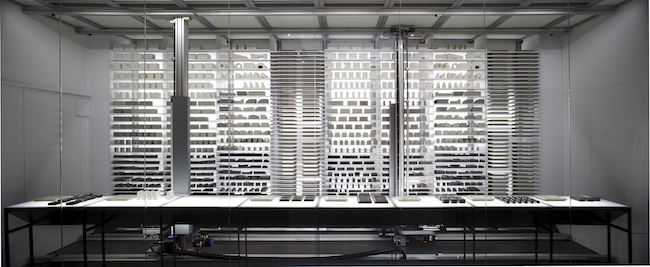
James Beckett. "Negative Space: A Scenario Generator for Clandestine Building in Africa" (2015). Robotics, painted wood, stickers, glass, canvas. Courtesy Wilfried Lentz Rotterdam and T293, Rome